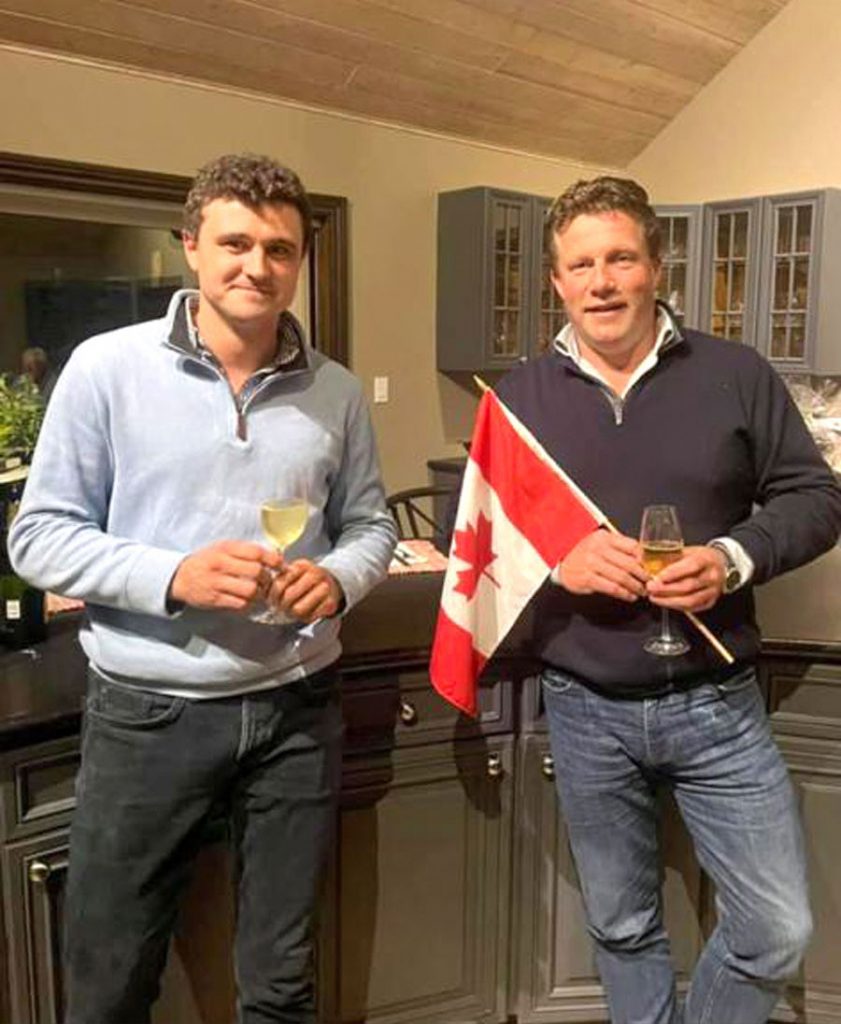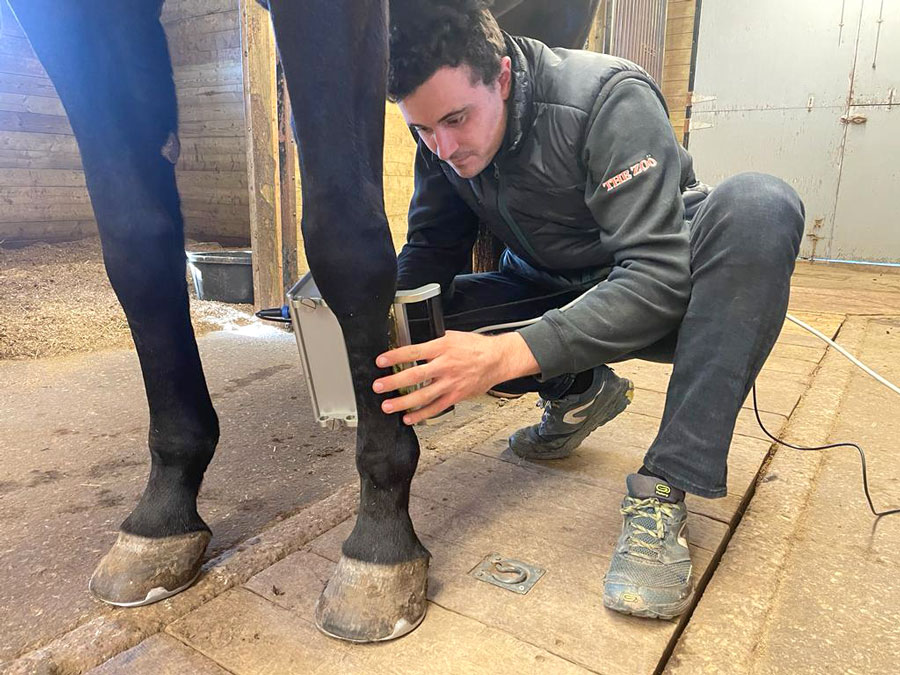ERIN – High injury rates in equine tendon and ligaments are common in the equine industry – to the point they are almost accepted as the “nature of the beast.”
Julien Moreau wants to change that misconception.
“We see the weakness on tendon and ligaments and that made me question, ‘how can we avoid injuries?’ Because it’s a huge part of the sport,” Moreau said, noting this happens across disciplines, from horse racing to the dressage ring.
Moreau has a lifetime of experience riding and training competitive horses in his homeland of France, but now calls Erin, where he has a training facility, home.
He has found his footing on Canadian soil by bringing a new technology from overseas that he believes will ensure his equine athletes are sound in their footing too.
The Ultrasound Tissue Characterization (UTC) technology is an advanced tendon tissue assessment tool he believes has potential to change the industry.
“Owners in North America buy so many horses from Europe that are real quality, but the injury rate here is huge. It’s incredible,” Moreau said.
“We lose too many good horses because of that, and it costs owners a lot of money too.”
Moreau wanted to find a solution that would help horses in their careers, and owners in their investment.
“Often, we hear from people that they put all their money into a horse and then they don’t have the data to analyze their risk of injury, or to rehabilitate the horse, if necessary,” Moreau said.
“I thought this was a huge advance for this sport and it had to be brought to Canada.”

Equine Tendon – Julien Moreau, left, and Henk Offereins, DVM.
Submitted photo
The UTC technology is used by Equine Tendon, an international company located in Kerry, Ireland. Founded by Henk Offereins, DVM, the company creates unique technologies and services that support horses by collecting reliable and accurate data that will help assess and optimize performance.
“We’re not really in the business of diagnosing or fixing tendons as such,” Offereins explains. “We’re in the business of assessing the state of the tendon – in relation to a certain amount of exercise or maybe in relation to an injury.”
He adds, “What this technology allows is to actually assess the responses of a tendon of exercise or loading.”
Offereins notes the effect of loading is well documented in sports medicine.
“It’s a concept that is well accepted in human medicine and management of hockey players. And that’s exactly what we’re doing. We are assessing the effect of loading,” he said.
“So, in that sense, I think the average athlete, or Canadian sports therapist would know about injuries and what it takes to prevent them … and any tool that can help you do that is a welcome addition to the industry.”
It’s as much about preventative care for the athlete as it is about injury and subsequent rehabilitation.
“The whole goal is to bring longevity to the horses; avoid injuries and bring longevity,” Moreau said.
The UTC technology can offer a personalized baseline of the tendon’s status.
“We measure the effect of the training on those tendons so then we’re able to adapt the training to each horse,” Moreau said.
“It’s like an insurance; you try to avoid the injury. And you know before there is something there that has a lower chance to repair.”
The UTC scanner technology can differentiate between different fibre types within the tendon. This allows assessment of percentages of healthy aligned fibres, the degree of scar tissue, the severity of a lesion and the effect on the tendon of the current exercise level, all in one scan.
“You have to see a tendon a bit like a rope. And before it breaks, it will slowly start giving way,” explains Offereins.
“That early stage is where the normal ultrasounds wouldn’t work, or other technologies wouldn’t pick up in a practical or economical way. So, what we can do is actually look at the horse and assess the tendon as part of the exercise regime, or injury, or performance level.”
Offereins adds, “You don’t need to be injured to be able to make use of the technology.”
Ultrasonographic tissue characterization is driven by a precision instrument that automatically moves a high-frequency ultrasonographic probe along the long axis of the tendon, collecting 600 transverse images at regular intervals of 0.2 mm.
“It’s drug free, which is important for the industry. It’s not invasive; we don’t inject anything,” Moreau explains. “It’s an ultrasound that measures the tendon, and the ultrasound is outside the leg.”
Using both hardware and software, the UTC creates a quantitative evaluation of tendon structural integrity.
“The scanner technology will standardize the assessment of the tendon,” Offereins explains. “That assessment is based on the analysis of the fibres, independent and not whether or not there’s holes or lack of depth in the tendon alone.”
The UTC will detect and display four different fibre types/patterns, the percentages of which, depending on location within the tendon, allows for accurate assessment of the extent of damage, the quality of healing and to establish the optimal exercise the tendon can handle to achieve optimal results.
“We’re able to be interactive with the analysis of the fibres,” Offereins said, noting this is what makes the UTC a unique tool.
“It allows assessments in a much more detailed level than a conventional ultrasound can, and even more than an MRI could, so it has its own place in tendon management.”
Another benefit, Moreau points out, is that the UTC equipment is portable, allowing the personal assessments to be performed on-site, at the horse’s home barn. That convenience is a cost-savings.
Offereins said the technology was born out of a need in the equine industry. While there was various research into the treatment of tendons, there wasn’t a standard framework to manage the information or a network to share the findings, though many horse owners were dealing with similar issues and challenges.
“So, that was actually where the whole thing started: to get similar data out of these tendons that are comparable between different horses, and between different countries and continents as such,” Offerein said. “This data may be individual, but in the broader network of data of other horses, it helps to create a very unique and thorough database.”
He explains that data can be shared with a horse’s team, from the owners to the trainers to the riders, to make an informed decision on the horse’s capability in the moment, if they are comfortable at their current performance level, or if there is a risk to consider.
“It’s part of the decision making around the career of a horse. You need to know whether the horse is comfortable in the amount of work and the loading of tendons or not, and that’s what the technology allows us to see,” Offereins confirms.
“We’re adding a layer of information to the industry that will then in turn will be helpful for all the other goals in that industry.”
Moreau agrees that the more information shared for the welfare of the horse, the greater the success of the team around it.
“It helps everyone be more efficient, including the veterinarians, but also the physiotherapists, the riders, trainers, the grooms. The more information for everyone, the better,” Moreau said.
“And it’s each individual horse because everyone trains different: different weather, different surface where the horses train on, different riders. Some trainers have the same injuries again and again, and some never have them. It means that the human effect is huge. So, it’s how can we be better managers for the athletes?”
Offereins said the UTC has filled the gap of providing useful data in an area of equine heath, where there is currently very little data.
It’s also building a case against the apathy and acceptance of high equine injury rates.
“That’s really a focus point for me is that the industry accepts this high injury rate and this poor recovery rate,” Offereins said. “But ultimately, some horses are put down, others are miserable in the field, but they’re not doing the job or living the life they could be living because of the injury or re-injury.
“And anything that can reduce injury risk, I think would be very strongly helping animal welfare in the wider sense. So that alone would be a good reason.”
For more information on Ultrasound Tissue Characterization, visit equinetendon.com.
To contact Julien Moreau, for North American coverage, email canada@equinetendon.com.




